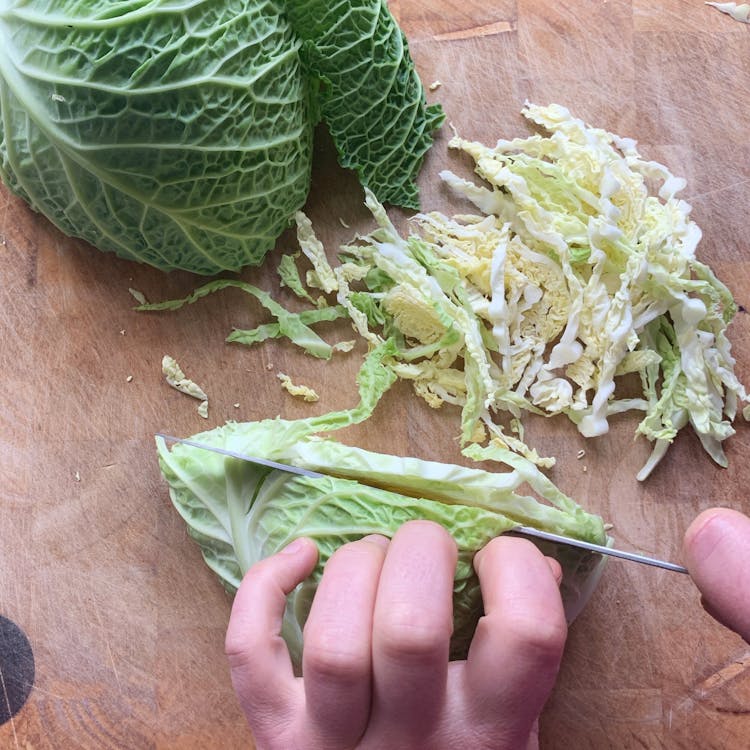How to store, prep, and cook Savoy Cabbage 6 different ways
“The blousy, deeply-ridged leaves of the savoy are what set it apart from its smooth, uniform cabbage cousins making it much more interesting to use and eat. With leaves that change texture, flavour and colour as you move inwards, you can find lots of different uses for the leaves so nothing needs to go to waste. Eat the dark green, hardy and gently bitter outside leaves braised or use as wrapping. The sweeter, pale yellow inside leaves are great eaten raw in salad and coleslaw.” - Georgia Levy (@georgia_levy_) ODDBOX friend and guest chef

TIP:
The outside leaves will take longer to cook than the inside leaves so if boiling, you may want to add them to the water first. The stem is delicious too, peel and finely slice it and include it when cooking the leaves.
HOW TO… STORE
When kept in a cool, dark place, savoy cabbages can last two weeks or even more. And if the outside leaves seem a bit sad and floppy, as long as they’re not discoloured, they’re still good to use and you’ll find the inside ones are still looking sprightly.
HOW TO… PREP
SHREDDED:
If your recipe calls for shredded leaves, cut the savoy in half through the base stem, then sit the savoy cut-side down on the chopping board and shred with a sharp knife.
WHOLE:
If your recipe calls for whole leaves, cut away the bottom few inches of the base stem to release the outer leaves. Make sure you retain this stem as it will provide extra texture to your dishes and has a wonderful, concentrated cabbage flavour. Give it a peel, then slice thinly or chop into chunks.
You can also use a whole cabbage in one go, so that nothing goes to waste. Make it the star of your meal by rubbing it in butter and herbs and roasting it whole in the oven and serving it with a few different veg as you would a piece of meat.
RAW:
Have a go at using your savoy raw, the inner leaves can be used as you would salad leaves. Shred and combine with other crunchy veg and a punchy, creamy dressing to make a coleslaw. Or rip up and toss with blue cheese, walnuts, parsley, red wine vinegar and olive oil to make a delicious salad.
PICKLED:
Or try making sauerkraut with the freshest inner leaves. Combine with veg like fennel, radishes and carrots, and spices such as cumin seeds, caraway and mustard seeds. Massage with 2g salt for every 100g vegetables, pack into a glass jar and leave to ferment at room temperature for 3-10 days.
HOW TO… COOK
Every part of the cabbage is delicious and useful, so here are a few ways to use this versatile vegetable from stem to outer leaf:
ROAST:
If you want to try eating the whole cabbage, make a spicy tomato sauce with cumin seeds, ground coriander, smoked paprika and chilli flakes. Cut the savoy into wedges, brown in oil, then add to the sauce with a little water, cover and cook at 180C for 45 minutes. Serve with toasted pumpkin seeds, crumbled feta and fresh coriander on top.
BAKE:
For a classic Northern Italian way of using savoy, try the alpine pasta dish, Pizzoccheri. Combine blanched leaves with fontina cheese, rosemary, sage, buckwheat (or wholewheat) pasta and potatoes for some serious comfort food.
BRAISE:
Gently fry sliced garlic, fennel seeds and chilli flakes in olive oil until fragrant, then throw in blanched savoy leaves for a few minutes for the ultimate way to eat your greens that goes with absolutely everything. Amazing with roast meat or fish or stirred through pasta.
WRAP:
Stir together browned pork mince, fried onions and cooked rice, wrap with blanched savoy leaves and bake in tomato sauce to make Polish stuffed cabbage.
SAUCE:
Boil the leaves in salted water with a few cloves of garlic, then transfer to a food processor with a handful of pine nuts/almonds and lots of extra-virgin olive oil. Blitz until smooth, then stir in Parmesan to make a wildly delicious pasta sauce that you can make with almost all green leaves.
LEFTOVER COOKED SAVOY?
Cooked savoy can be stirred through mashed potato with lots of butter to make colcannon or fry this to make bubble and squeak.

